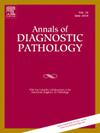Cytomorphologic analysis of pulmonary neuroendocrine tumors – The physical effect of abrasion and aspiration on cytomorphology
IF 1.5
4区 医学
Q3 PATHOLOGY
引用次数: 0
Abstract
Neuroendocrine tumors of the lung display characteristic cytomorphologic features allowing direct diagnosis. The specificity of these features in distinguishing subtypes of neuroendocrine tumors, and their differences among types of cytologic specimen poses as interpretative potential pitfalls. This study reviewed and compared bronchial, effusion fluid and fine-needle aspiration cytology specimens of neuroendocrine tumors of the lung to address these issues. Histology-proven cytology specimens of neuroendocrine tumors were reviewed for cytomorphological parameters focusing on reported specific neuroendocrine nuclear and background features. Totally, 46 cases (26 bronchial, 11 effusion and 9 aspirate specimens), corresponding to 37 small cell carcinomas, 7 neuroendocrine carcinomas and 2 carcinoids were reviewed. Nuclear moulding (n = 35/37, 95 %), naked nuclei (n = 33/37, 89 %) and marked nuclear irregularity (n = 32/37, 86 %) were the three most common features of small cell carcinoma. The only specific feature for small cell carcinoma was the lack of prominent nucleoli (p = 0.004). For pulmonary carcinoids, in addition to the above features, other features associated with neuroendocrine carcinoma reviewed including crush artifact and necrotic material were absent. Compared to bronchial and aspiration cytology, crush artifact (p < 0.001) and necrotic material (p = 0.014) were absent on effusion fluid specimens and naked nuclei were less frequently seen (p = 0.022), while prominent nucleoli were more often observed (p = 0.005). Nuclear moulding, irregularity and naked nuclei are common but not unique features to small cell carcinomas. Effusion fluid specimens have “cleaner” backgrounds while displaying greater nuclear atypia. The type of cytologic preparation/specimen is an important factor which must be considered during diagnostic interpretation.
肺神经内分泌肿瘤的细胞形态学分析--磨损和抽吸对细胞形态学的物理影响。
肺部神经内分泌肿瘤具有特征性的细胞形态学特征,可直接进行诊断。这些特征在区分神经内分泌肿瘤亚型方面的特异性及其在不同类型细胞学标本中的差异构成了解释上的潜在隐患。本研究对肺部神经内分泌肿瘤的支气管、渗出液和细针穿刺细胞学标本进行了回顾和比较,以解决这些问题。研究人员对经组织学证实的神经内分泌肿瘤细胞学标本进行了细胞形态学参数审查,重点关注已报道的特定神经内分泌核特征和背景特征。共审查了 46 个病例(26 个支气管标本、11 个渗出标本和 9 个吸出标本),分别对应 37 个小细胞癌、7 个神经内分泌癌和 2 个类癌。核成型(35/37,95%)、裸核(33/37,89%)和核明显不规则(32/37,86%)是小细胞癌最常见的三个特征。小细胞癌的唯一特异性特征是缺乏突出的核小体(p = 0.004)。就肺类癌而言,除上述特征外,还缺乏与神经内分泌癌相关的其他特征,包括挤压假象和坏死物质。与支气管细胞学和抽吸细胞学相比,挤压伪影(p
本文章由计算机程序翻译,如有差异,请以英文原文为准。
求助全文
约1分钟内获得全文
求助全文
来源期刊
CiteScore
3.90
自引率
5.00%
发文量
149
审稿时长
26 days
期刊介绍:
A peer-reviewed journal devoted to the publication of articles dealing with traditional morphologic studies using standard diagnostic techniques and stressing clinicopathological correlations and scientific observation of relevance to the daily practice of pathology. Special features include pathologic-radiologic correlations and pathologic-cytologic correlations.

 求助内容:
求助内容: 应助结果提醒方式:
应助结果提醒方式:


